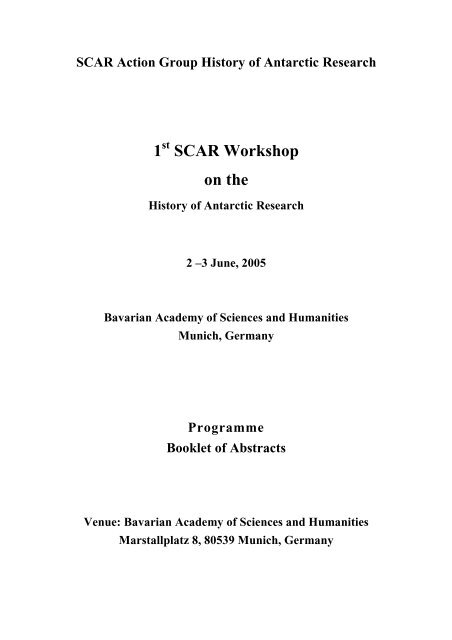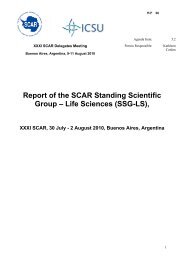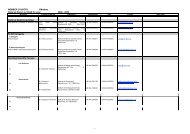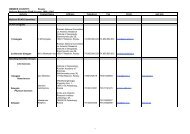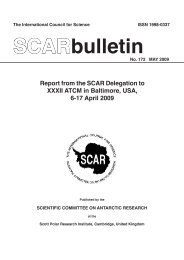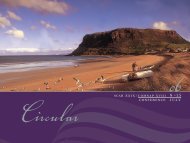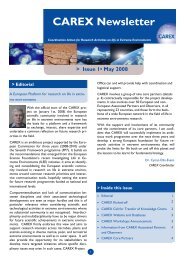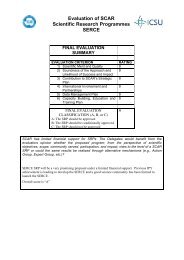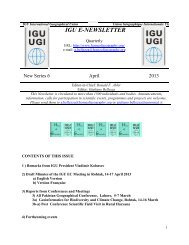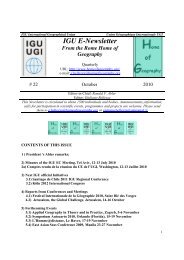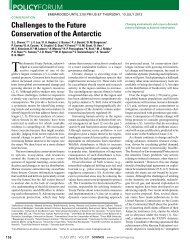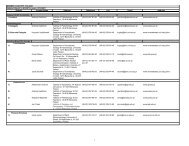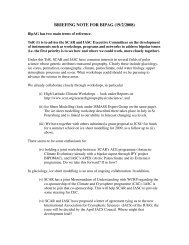SCAR Action Group History of Antarctic Research 1
SCAR Action Group History of Antarctic Research 1
SCAR Action Group History of Antarctic Research 1
You also want an ePaper? Increase the reach of your titles
YUMPU automatically turns print PDFs into web optimized ePapers that Google loves.
<strong>SCAR</strong> <strong>Action</strong> <strong>Group</strong> <strong>History</strong> <strong>of</strong> <strong>Antarctic</strong> <strong>Research</strong><br />
1 st <strong>SCAR</strong> Workshop<br />
on the<br />
<strong>History</strong> <strong>of</strong> <strong>Antarctic</strong> <strong>Research</strong><br />
2 –3 June, 2005<br />
Bavarian Academy <strong>of</strong> Sciences and Humanities<br />
Munich, Germany<br />
Programme<br />
Booklet <strong>of</strong> Abstracts<br />
Venue: Bavarian Academy <strong>of</strong> Sciences and Humanities<br />
Marstallplatz 8, 80539 Munich, Germany
Editor and layout: Cornelia Lüdecke, University <strong>of</strong> Hamburg<br />
The workshop is sponsored by Scientific Committee <strong>of</strong> <strong>Antarctic</strong> <strong>Research</strong>, Deutsche<br />
Gesellschaft für Polarforschung, Deutsches Zentrum für Luft- und Raumfahrt, Schwerpunkt<br />
Geschichte der Naturwissenschaften (University <strong>of</strong> Hamburg), and Spaten-Löwenbräu-<br />
Gruppe.<br />
It is also supported by Kommission für Glaziologie der Bayerischen Akademie der Wissen-<br />
schaften.<br />
2
Thursday 2 June 2005<br />
8: 30-9:00 Registration<br />
09:00-9:15 Workshop Welcome and Opening<br />
Ludwig Braun, Commission <strong>of</strong> Glaciology, Bayerische Akademie der<br />
Wissenschaften Munich<br />
Cornelia Lüdecke, President <strong>of</strong> <strong>SCAR</strong> <strong>Action</strong> <strong>Group</strong> <strong>History</strong> <strong>of</strong> <strong>Antarctic</strong> <strong>Research</strong>,<br />
Munich<br />
Aant Elzinga, Department <strong>of</strong> <strong>History</strong> <strong>of</strong> Ideas and Theory <strong>of</strong> Science, Göteborg,<br />
Sweden<br />
9:15-13:00 Session I Chair: Ludwig Braun<br />
09:15-10:15 The dawn <strong>of</strong> <strong>Antarctic</strong> scientific consciousness<br />
Jorge Berguño, Chilean <strong>Antarctic</strong> Institute, Santiago, Chile<br />
10:15-10:30 Poster Presentation<br />
Changes to <strong>Antarctic</strong> Identity Rhetoric<br />
Jason Davis, The Ohio State University, USA<br />
<strong>History</strong> <strong>of</strong> <strong>Antarctic</strong> <strong>Research</strong>: The Australian Context<br />
David Michael Dodd, Royal Society <strong>of</strong> Victoria / University <strong>of</strong> Melbourne,<br />
Melbourne, Australia<br />
Wilhelm Filchner and <strong>Antarctic</strong>a<br />
Helmut Hornik, Filchner Archive, Munich, Germany and<br />
Cornelia Lüdecke, Centre for the <strong>History</strong> <strong>of</strong> Science, University <strong>of</strong><br />
Hamburg, Germany<br />
10:30-11:00 C<strong>of</strong>fee Break - Poster Session<br />
11:00-12:00 Argentine Scientific Interests in <strong>Antarctic</strong>a, 1946-1959<br />
Adrian Howkins, University <strong>of</strong> Texas at Austin, USA<br />
12:00-13:00 The U.S. <strong>Antarctic</strong> Oversnow Geophysical-Glaciological <strong>Research</strong> Program <strong>of</strong><br />
the International Geophysical Year (IGY) 1957-58 from the View <strong>of</strong> a <strong>Research</strong><br />
Scientist Participant<br />
John C. Behrendt, Institute <strong>of</strong> Arctic and Alpine <strong>Research</strong>, University <strong>of</strong><br />
Colorado, USA<br />
13:00-14:00 Lunch<br />
14:00-18:00 Session II Chair: Cornelia Lüdecke<br />
14:00-15:00 The Political Dimensions <strong>of</strong> the NBS - Expedition to <strong>Antarctic</strong>a 1949-52<br />
Lisbeth Lewander, Department <strong>of</strong> Gender Studies, Göteborg, Sweden<br />
15:00-16:00 The Swedish non-participation in the <strong>Antarctic</strong> leg <strong>of</strong> the IGY<br />
Aant Elzinga, Department <strong>of</strong> <strong>History</strong> <strong>of</strong> Ideas and Theory <strong>of</strong> Science,<br />
Göteborg, Sweden<br />
3
16:00-16:30 C<strong>of</strong>fee Break - Poster Session<br />
16:30-17:30 Russia in the <strong>Antarctic</strong><br />
V.M. Kotlyakov, M.Yu. Moskalevsky,Institute <strong>of</strong> Geography Russian<br />
Academy <strong>of</strong> Sciences, Moscow, Russia, and<br />
V.V. Lukin, and A. V. Klepikov, Arctic and <strong>Antarctic</strong> <strong>Research</strong> Institute <strong>of</strong><br />
the Roshydromet, St. Petersburg, Russia<br />
17:30-18:00 Discussion on next <strong>SCAR</strong> workshop<br />
19:00 Optional dinner on private expenses<br />
Friday 3 June 2005<br />
9:00-12:30 Session III Chair: Aant Elzinga<br />
09:00-10:00 <strong>Antarctic</strong>a in the 1980s: Subject <strong>of</strong> international politics<br />
Peter Abbink, Arctic Centre, University <strong>of</strong> Groningen, The Netherlands<br />
10:00-11:00 The start <strong>of</strong> Dutch involvement in <strong>Antarctic</strong> research<br />
Johan van Bennekom, retired from Royal Netherlands Institute for Sea<br />
<strong>Research</strong>, Texel, The Netherlands<br />
11:00-11:30 C<strong>of</strong>fee Break - Poster Session<br />
11:30-12:30 The <strong>History</strong> <strong>of</strong> Astrophysics in <strong>Antarctic</strong>a<br />
Balthasar Indermuehle, University <strong>of</strong> New South Wales, Australia<br />
12:30-13:30 Lunch<br />
13:30-15:30 Session IV Chair: Aant Elzinga<br />
13:30-14:30 Karl Maria Herrligk<strong>of</strong>fer’s private „German South Pole Expedition“ 1957/58 –<br />
a failed initiative<br />
Cornelia Lüdecke, Centre for the <strong>History</strong> <strong>of</strong> Science, University <strong>of</strong> Hamburg,<br />
Germany<br />
14:30-15:30 Final discussion<br />
End <strong>of</strong> Workshop 15:30<br />
4
<strong>Action</strong> <strong>Group</strong> on the <strong>History</strong> <strong>of</strong> <strong>Antarctic</strong> <strong>Research</strong><br />
The 50 th anniversary <strong>of</strong> the International Geophysical Year is in 2007-2008. On this<br />
occasion an <strong>Action</strong> <strong>Group</strong> on the “<strong>History</strong> <strong>of</strong> institutionalisation <strong>of</strong> <strong>Antarctic</strong> <strong>Research</strong><br />
within <strong>SCAR</strong>” (short: “AG <strong>History</strong> <strong>of</strong> <strong>Antarctic</strong> <strong>Research</strong>” or “<strong>SCAR</strong> <strong>History</strong> AG”) was<br />
established under the Delegate Committee on Standing Committees and Outreach <strong>of</strong><br />
<strong>SCAR</strong> during the <strong>SCAR</strong> XXXIII Delegates Meeting at Bremerhaven in October 2004.<br />
It is the first international and interdisciplinary group devoted to the history <strong>of</strong> polar<br />
research.<br />
The Aim <strong>of</strong> the <strong>Action</strong> <strong>Group</strong><br />
The aim <strong>of</strong> this working group is to obtain insight into the evolution <strong>of</strong> <strong>Antarctic</strong><br />
research and the emergence and development <strong>of</strong> institutions to co-ordinate what was<br />
first called the Special Committee, and then Scientific Committee on <strong>Antarctic</strong> <strong>Research</strong><br />
(<strong>SCAR</strong>). We plan to study to what degree research in the <strong>Antarctic</strong> has been driven by<br />
scientific criteria, and to what extent compromises were made in the light <strong>of</strong> political<br />
barriers, levels <strong>of</strong> technological development, logistical limitations, and physical<br />
hazards.<br />
In historical perspective, a review will be made <strong>of</strong> essential background factors, both<br />
scientific and non-scientific, at work when nations were moved to participate in the<br />
International Geophysical Year (IGY, 1957-1958) at the time <strong>of</strong> the Cold War. Pertinent<br />
in this respect are the different roles played by non-governmental scientific organisations<br />
as distinct from intergovernmental organisations or modes <strong>of</strong> international organisation.<br />
Additional socio-cultural and political background factors will be considered<br />
with regard to major nations that chose not to contribute to the IGY.<br />
Our Plans<br />
We plan to discuss several aspects <strong>of</strong> the phase prior to the International Geophysical<br />
Year and the initial attempts to institutionalise polar research. Traditionally, field<br />
science practised in remote geographical regions was either a byproduct <strong>of</strong> exploration<br />
or an activity exploited by economical interests or territorial claimants. An important<br />
aspect <strong>of</strong> the early international polar year initiatives in the past has been the requirement<br />
that expeditions and projects be driven by scientific research instead <strong>of</strong> exploration.<br />
This principle was reiterated in Belgium by a number <strong>of</strong> internationally minded<br />
scientists (Henryk Arctowski, Otto Nordenskjöld, Jean Charcot, William Speirs Bruce,<br />
and others). This was when efforts were afoot to establish an international polar<br />
commission, a hybrid combination <strong>of</strong> inter-governmental and non-governmental<br />
scientific and other organizations. Although such a commission was actually founded, it<br />
had a very marginal influence on events and was soon eclipsed by the First World War.<br />
5
Our questions to the history <strong>of</strong> <strong>Antarctic</strong> <strong>Research</strong><br />
Engagement: What motivated an individual person or a given country to engage in<br />
<strong>Antarctic</strong> research?<br />
Did the motivation differ during different historical time periods?<br />
Is it possible to identify different types <strong>of</strong> role-figures?<br />
Realisation : How were <strong>Antarctic</strong> research agendas set up and implemented?<br />
What kind <strong>of</strong> arguments were used to promote <strong>Antarctic</strong> research?<br />
What sort <strong>of</strong> funding was available, and did different modes <strong>of</strong> funding<br />
affect the character <strong>of</strong> an expedition and the way it was conducted?<br />
Co-operation: When did co-operation for research pertaining to <strong>Antarctic</strong>a occur, and<br />
what was the general orientation and scope?<br />
What were some <strong>of</strong> the obstacles associated with multi-lateral or international<br />
co-operation?<br />
Leading figures: In the context <strong>of</strong> different national settings and perspectives, who were<br />
the persons that came to be recognised as leading figures in <strong>Antarctic</strong><br />
research, and for what reasons?<br />
To what extent did some scientists emerge as diplomats within science, or<br />
beyond it in the international political arena?<br />
How were they regarded by their scientific colleagues, by politicians, media,<br />
etc?<br />
The answers may be found in our workshops.<br />
6
ABSTRACTS<br />
<strong>Antarctic</strong>a in the 1980s: Subject <strong>of</strong> international politics<br />
Peter Abbink, b.p.abbink@rug.nl<br />
Arctic Centre, University <strong>of</strong> Groningen, Groningen, The Netherlands<br />
After the <strong>Antarctic</strong> Treaty had come into force in 1961, <strong>Antarctic</strong>a was not a big issue in<br />
international affairs at all. The twelve signatory parties <strong>of</strong> the Treaty managed to<br />
neutralise the sovereignty conflicts in the <strong>Antarctic</strong> area, which had blazed up in the<br />
1940s and 1950s. They preserved the <strong>Antarctic</strong> area for peaceful purposes only, in<br />
particular for scientific research. For about two decades, this ‘paradisiacal’ area stood<br />
alo<strong>of</strong> from the international arena, which was dominated by the Cold War, decolonization<br />
and war in the Middle East.<br />
In the 1980s <strong>Antarctic</strong>a moved gradually towards the centre <strong>of</strong> the international stage. A<br />
growing number <strong>of</strong> governments and international organizations were interested in<br />
<strong>Antarctic</strong>a. In my presentation I will describe four developments in the 1980’s, which<br />
made this period the most dynamic and turbulent period in the history <strong>of</strong> the <strong>Antarctic</strong><br />
Treaty System (ATS). These developments are:<br />
• The intensifying debate within the ATS, particularly about a minerals regime.<br />
• The attack on the ATS in UN circles. ‘The question <strong>of</strong> <strong>Antarctic</strong>a’ became an<br />
annual consideration in the United Nations General Assembly.<br />
• The increasing support for the ATS. In the 1980s the ATS expanded rapidly.<br />
The group <strong>of</strong> both non-consultative and consultative parties <strong>of</strong> the <strong>Antarctic</strong><br />
Treaty almost doubled in ten years time.<br />
• The growing concern for the conservation <strong>of</strong> the <strong>Antarctic</strong> natural environment.<br />
I shall elaborate on the explaining factors, such as speculations about the resource<br />
potential <strong>of</strong> the <strong>Antarctic</strong> region, the prospect <strong>of</strong> a possible review <strong>of</strong> the <strong>Antarctic</strong><br />
Treaty System in 1991, the general increase <strong>of</strong> environmental concerns and the publication<br />
<strong>of</strong> certain scientific results.<br />
This oral paper is part <strong>of</strong> my PhD research ‘Dutch <strong>Antarctic</strong> policy and research since<br />
1945, in comparison with that <strong>of</strong> Belgium and Germany’.<br />
7
The U.S. <strong>Antarctic</strong> Oversnow Geophysical-Glaciological <strong>Research</strong><br />
Program <strong>of</strong> the International Geophysical Year (IGY) 1957-58<br />
from the View <strong>of</strong> a <strong>Research</strong> Scientist Participant<br />
John C. Behrendt, John.Behrendt@colorado.edu<br />
Institute <strong>of</strong> Arctic and Alpine <strong>Research</strong>, University <strong>of</strong> Colorado, Boulder, USA<br />
also, U.S. Geological Survey, Denver, CO 80225, USA<br />
When 12 countries established scientific stations in <strong>Antarctic</strong>a for the 1957-58 International<br />
Geophysical Year (IGY) the Cold War was at its height, seven countries had made<br />
claims in <strong>Antarctic</strong>a, and the <strong>Antarctic</strong> Treaty was a few years in the future. The U.S.<br />
program was operated by the Navy and territorial claims were secretly made at several<br />
locations during the IGY; these were never <strong>of</strong>ficially announced and the U.S. remains a<br />
non-claimant state. I was a graduate student geophysicist (assistant seismologist) on the<br />
unexplored Filchner-Ronne Ice Shelf as part <strong>of</strong> the only large scale field project <strong>of</strong> the<br />
U.S. program. Starting in 1956, the U.S. began a series <strong>of</strong> oversnow traverses making<br />
seismic reflection ice soundings (and other geophysical measurements) and glaciological<br />
studies to determine the thickness and budget <strong>of</strong> the <strong>Antarctic</strong> Ice Sheet. The USSR and<br />
France made similar traverses coordinated through the IGY. Although geology and<br />
topographic mapping were not part <strong>of</strong> the IGY program because <strong>of</strong> the claims issue and<br />
the possibility <strong>of</strong> mineral resources discoveries, the oversnow traverse parties did geologic<br />
work where unknown mountains were discovered. The oversnow traverses continued<br />
through 1966 and resulted in an excellent first approximation <strong>of</strong> the snow surface<br />
elevation, ice thickness and bed topography <strong>of</strong> <strong>Antarctic</strong>a, as well as mean annual<br />
temperature <strong>of</strong> that era and snow accumulation.<br />
The vacuum tube dictated the logistics <strong>of</strong> the oversnow traverse program. Seismic equipment<br />
including heavy batteries weighed about 500 kg. Therefore a Sno-Cat tracked<br />
vehicle was needed to carry this load. Usually three such vehicles were needed for safety.<br />
Because about 3-4 l/km/Sno-Cat fuel was consumed, as much as 120 kg/day <strong>of</strong> fuel was<br />
required. A resupply flight could only carry only about 600 kg/flight (varying greatly as to<br />
range and type <strong>of</strong> aircraft), the major air logistic program <strong>of</strong> the U.S. IGY program were<br />
the three oversnow traverses (other than the resupply <strong>of</strong> the seven U.S. stations in <strong>Antarctic</strong>a.<br />
The Filchner Ice Traverse, on which I participated, encountered many crevasses.<br />
Vehicles broke through thin snow bridges and one man fell deep into a crevasse. Fortunately<br />
there were no deaths and only one serious injury resulting from crevasse accidents<br />
on the U.S. Program.<br />
Because <strong>of</strong> hidden agenda related to the Cold War, U.S. (and possibly Soviet) scientists<br />
felt that <strong>Antarctic</strong> research was a duty rather than a privilege as today. The U.S. air<br />
program averaged 3.8 deaths/year from 1955-1961 in contrast to 0.1 death/year since<br />
1970. At least three U.S. scientist died in the early period <strong>of</strong> the U.S. program. When, if<br />
ever, do the ends justify the means? It is one thing if mature individual researchers,<br />
pr<strong>of</strong>essional technicians, aviators, and others take risks with full awareness <strong>of</strong> the hazards.<br />
But it is quite another thing if relatively naive graduate students and new Ph.D.s looking<br />
for adventure, such as my colleagues and I in the 1956-1962 period, are sent into harm's<br />
way without knowing specifically what they will face, by ambitious senior researchers<br />
pursuing their personal scientific objectives, even though these may be <strong>of</strong> vital national<br />
and international importance. I have worked both sides <strong>of</strong> this street in the past 50 years.<br />
8
The start <strong>of</strong> Dutch involvement in <strong>Antarctic</strong> research<br />
Johan van Bennekom, bennekom@kwarteel.nl<br />
retired from the Royal Netherlands Institute for Sea <strong>Research</strong>, Texel, The Netherlands<br />
<strong>Research</strong> by Dutch scientists in the <strong>Antarctic</strong> was carried out during two periods. In the<br />
mid-1960's, scientists from the Royal Netherlands Meteorological Institute were part <strong>of</strong><br />
the overwintering crew in three expeditions to the Belgian-Dutch Station "King Baudouin",<br />
situated on the Princess Ragnhild coast. After the last expedition in 1967, the<br />
cooperation ended because no agreement could be reached on continuation and / or<br />
follow-up programs. As a consequence, there remained only little "polar experience" in<br />
the Netherlands.<br />
In my presentation I will concentrate on the second period, starting about 1980, when<br />
Dutch interest in the <strong>Antarctic</strong> grew again, at first outside the scientific community. I<br />
will also pay tribute to the people involved. The political scene in those days was<br />
dominated by the possible revision <strong>of</strong> the <strong>Antarctic</strong> Treaty in 1991. Regulating the<br />
permission to explore for precious minerals and oil was an important issue. This<br />
evoked activity in different circles; the prospect <strong>of</strong> exploitation led government agencies<br />
to ensure that their countries would not miss part <strong>of</strong> the cake, however imaginary. On<br />
the other hand, NGO's were concerned that exploration, let alone exploitation would<br />
cause irrevocable damage to the fragile ecosystems <strong>of</strong> the <strong>Antarctic</strong> continent as well as<br />
the surrounding seas. The NGO's approached their national committees to lobby for a<br />
conservation policy towards <strong>Antarctic</strong>a; in the Netherlands this role was taken up by the<br />
Dutch committee <strong>of</strong> the International Union for the Conservation <strong>of</strong> Nature (IUCN).<br />
From 1980 onwards, this committee hosted a working group consisting <strong>of</strong> representatives<br />
<strong>of</strong> various NGO's, government ministries and scientists <strong>of</strong> different disciplines. It<br />
goes without saying that all lobbying to ensure a greater Dutch influence in <strong>Antarctic</strong><br />
matters would be in vain if there was't a program <strong>of</strong> "substantial scientific research" in<br />
the <strong>Antarctic</strong>. Despite a growing interest among Dutch scientists to work in the <strong>Antarctic</strong>,<br />
in the beginning ornithologists, oceanographers, geologists and glaciologists,<br />
results rather than plans were required.<br />
There was and still is a generous hospitality to accomodate foreigners on expeditions,<br />
when the planned research fits into the purpose <strong>of</strong> the expedition. But without a polar<br />
tradition, competition for the always scarce funding needed for travel and equipment<br />
was difficult.<br />
It took several years before a small amount <strong>of</strong> money, earmarked for <strong>Antarctic</strong> research<br />
could be secured for pilot projects for a period <strong>of</strong> three years. It took a long time, mainly<br />
because it was realized that <strong>Antarctic</strong> research would be a commitment for much<br />
more than 3 years. The budget increased; under the umbrella <strong>of</strong> the Dutch science foundation<br />
(NWO) an <strong>Antarctic</strong> committee was set up in 1985. In 1990 the Netherlands<br />
were granted consultative status in the Treaty. The science oriented attitude was<br />
apparent from the fact that no Dutch <strong>Antarctic</strong> Station was established. The limited<br />
financial means made it more fruitful to support logistics <strong>of</strong> other countries in a variety<br />
<strong>of</strong> cooperative projects, than establishing a small station in an "easy" area, where<br />
already many stations exist.<br />
9
The dawn <strong>of</strong> <strong>Antarctic</strong> Scientific Conciousness<br />
Jorge Berguño, jberguno@inach.cl<br />
Chilean <strong>Antarctic</strong> Institute, Santiago, Chile<br />
1. The roots <strong>of</strong> the gigantic effort in international cooperation concerning the Southern<br />
Continent may be found in the late eighteenth century scientific expeditions <strong>of</strong><br />
James Cook, La Pérouse, Malaspina and, at the start <strong>of</strong> the nineteenth century,<br />
Bellingshausen and Foster. Each one tries to avoid the tracks <strong>of</strong> its predecessors.<br />
Authorities in the ports <strong>of</strong> call are always respectful and keen to cooperate with the<br />
goals <strong>of</strong> these maritime expeditions. The eighteen century Anglo-Spanish Treasties<br />
consolidate a statu quo in the Southern parts <strong>of</strong> South America (Vide San Lorenzo or<br />
Nootka Sound Treaty 1790) that contributes to a climate <strong>of</strong> friendly relations between<br />
maritime powers, both among themselves and with their colonial establishments.<br />
2. The intelectual construction <strong>of</strong> <strong>Antarctic</strong>a is an accomplishment <strong>of</strong> the nineteenth<br />
century. Not only governments and their agencies and instrumentalities, but the explorers<br />
themselves, learned and scientific societies, international congresses and an<br />
atmosphere conducive to international cooperation provide the fabric for the advancement<br />
<strong>of</strong> a common objective. However, the history <strong>of</strong> scientific cooperation in<br />
<strong>Antarctic</strong>a and elsewhere is inseparable from a history <strong>of</strong> scientific ideas and, within<br />
that context, the advance towards the notion <strong>of</strong> concerted, comparative observations<br />
in the polar regions.<br />
3. Halley´s observations <strong>of</strong> magnetic variations in the Paramour, Hansteen´s “Magnetism<br />
<strong>of</strong> the Earth” (1819), Baron von Humboldt´s suggestion that the origin <strong>of</strong><br />
magnetic perturbations was cosmic, and Gauss´s prediction that the South Magnetic<br />
Pole would be found near latitude 66° S and longitude 146° E, in spite <strong>of</strong> his own<br />
lack <strong>of</strong> interest in the matter led to the search for a south magnetic pole in <strong>Antarctic</strong>a<br />
by Dumont d´Urville, Wilkes and Ross. In addition to the commonly highlighted<br />
“magnetic crusade”, three scientific disciplines played a key role in the scientific<br />
discovery <strong>of</strong> <strong>Antarctic</strong>a: astronomy, meteorology and oceanography.<br />
4. Astronomy is not <strong>of</strong>ten considered as crucial in this respect, but a significant step<br />
towards comparative observations in both hemispheres took place, when a German<br />
mathematician, Dr. Christian L. Gerling, <strong>of</strong> Marburg, wrote in April 1847 a letter to<br />
Lieutenant J.M. Gillis, USN, from the US Naval Observatory, in which he maintained<br />
that new and more accurate measurement <strong>of</strong> the solar parallax or a confirmation<br />
<strong>of</strong> the existing figure could be obtained by a series <strong>of</strong> observations <strong>of</strong> Venus<br />
carried out during approximately the same period in both the northern and southern<br />
hemispheres. When Gillis selected Washington D.C. and a spot near Santiago,<br />
Chile, for his simultaneous and opposite observations, the Chilean National Astronomical<br />
Observatory was born, whith a pupil <strong>of</strong> Gerling at Marburg, Carlos Moesta,<br />
as its first Director. At the turn <strong>of</strong> the century, the Director <strong>of</strong> the Observatory,<br />
French born Jean-Marie Obrecht, became an influential member <strong>of</strong> the first Chilean<br />
<strong>Antarctic</strong> Commission, set up in 1906.<br />
10
5. Comparative observations in both polar regions were advocated by Otto Nordenskjöld,<br />
who prepared himself practically and scientifically for field work in Tierra<br />
del Fuego in 1895-97 with advice from his uncle Baron A.E. Nordenskiöld, who had<br />
made plans in 1887, in cooperation with the government <strong>of</strong> Victoria, Australia, for<br />
an <strong>Antarctic</strong> expedition which did not succeed. Drygalski recalled that early initiative<br />
when he wrote that “the South Pole problem bore in upon me at various times,<br />
when I was working on the Ice-Age phenomena, when I heard that interest had been<br />
aroused in Australia, and that money was beginning to come in support <strong>of</strong> an expedition<br />
under Nordenskjöld leadership, I felt I would like to join him as well”.<br />
6. This importance <strong>of</strong> sub-<strong>Antarctic</strong> regions for research in <strong>Antarctic</strong>a is underlined.<br />
An expedition planned to <strong>Antarctic</strong>a by O. Nordenskjöld with the Chilean Scientific<br />
Society in 1896 failed, but the Swedish <strong>Antarctic</strong> Expedition did depart in 1901. A<br />
practical lesson may be drawn from the transmission <strong>of</strong> knowledge from one explorer<br />
to another. Before leaving for Tierra del Fuego, O. Nordenskjöld visited three<br />
experts: Pr<strong>of</strong>essor Steinman <strong>of</strong> Freiburg, M. Rousson in Paris, and Dr. Michaelsen<br />
<strong>of</strong> Hamburg. Subsequently the Swedish Government requested from Chile: “the<br />
same facilities and advantages allowed a German expedition under the guidance <strong>of</strong><br />
Dr. W. Michaelsen from the Natural Historical Museum in Hamburg”. This is an<br />
early antecedent <strong>of</strong> the freedom and cooperation nowadays guaranteed by the<br />
<strong>Antarctic</strong> Treaty.<br />
Changes to <strong>Antarctic</strong> Identity Rhetoric<br />
Jason Davis, davis.1937@osu.edu<br />
Department <strong>of</strong> Geography, The Ohio State University, Columbus, USA<br />
How has <strong>Antarctic</strong> Identity changed over the years? While attitudes about <strong>Antarctic</strong>a<br />
were largely nationalistic and colonial at the start <strong>of</strong> its exploration in the early 1900s,<br />
there was a gradual shift towards a conception <strong>of</strong> <strong>Antarctic</strong>a as a "laboratory for<br />
science" during the International Geophysical Year <strong>of</strong> 1957-58. Since then, environmental<br />
movements identified <strong>Antarctic</strong>a as a potential "World Park" and the idea <strong>of</strong><br />
<strong>Antarctic</strong>a as an unspoiled wilderness has been popularized.<br />
I will examine these shifting attitudes and beliefs regarding the <strong>Antarctic</strong> Identity<br />
through the examination <strong>of</strong> rhetorical references to <strong>Antarctic</strong>a through books, speeches,<br />
and treaties. I reference American sources on <strong>Antarctic</strong>a such as Admiral Richard Byrd<br />
and the National Science Foundation. By placing their rhetorical references to <strong>Antarctic</strong>a<br />
on a timeline, I hope to show the gradual transformation <strong>of</strong> attitudes towards the<br />
continent and their reflection in governance. This has impacts on how <strong>Antarctic</strong>a is<br />
governed and what priorities are stressed in that governance.<br />
11
<strong>History</strong> <strong>of</strong> <strong>Antarctic</strong> <strong>Research</strong>: The Australian context<br />
David Michael Dodd, daviddodd@optusnet.com.au<br />
Honorary Fellow, The Australian Centre, The University <strong>of</strong> Melbourne and<br />
Advisor to the IPY Planning Committee, Royal Society <strong>of</strong> Victoria, Melbourne<br />
The <strong>History</strong> <strong>of</strong> Australian <strong>Antarctic</strong> <strong>Research</strong> is being examined within the context <strong>of</strong><br />
Australia’s involvement in <strong>Antarctic</strong>a during the first three Polar Years, with particular<br />
reference to the interest shown by early scientific societies, scientific institutions and<br />
governmental agencies.<br />
The activities <strong>of</strong> these agencies are being further examined within the context <strong>of</strong> the<br />
four Workshop Themes during each Polar Year time frame. The establishment <strong>of</strong> the<br />
short lived Australian <strong>Antarctic</strong> Committee 1886/88, which grew out <strong>of</strong> the activities <strong>of</strong><br />
the first Polar Year 1882/83 and the role played by Royal Society <strong>of</strong> Victoria and<br />
European scientists both in Australia and overseas (Neumayer, etc., in developing<br />
Australia’s interest in <strong>Antarctic</strong>a) is also being examined. Within a purely historical<br />
context, Australia’s association with early <strong>Antarctic</strong> and Sub-<strong>Antarctic</strong> exploration from<br />
the 1800’s to the Challenger Expedition <strong>of</strong> 1874 will also be documented. The ‘Heroic<br />
Age’ activities centred on Australian <strong>Antarctic</strong> Territory and the Ross Dependency,<br />
followed by the Second Polar Year activities (the Mawson Years) and the Third Polar<br />
Year (IGY1957/58) activities (the Law Years) and <strong>Antarctic</strong> <strong>Research</strong> in the Modern<br />
era – the past 40 years, will be examined.<br />
The treatise will form a valuable backdrop to the Royal Society <strong>of</strong> Victoria’s voyages <strong>of</strong><br />
scientific discovery for young scientists (refer to the RSV-INTREPID - IPY project No<br />
81), to be conducted during the forthcoming IPY 2007-2008 program.<br />
The Swedish non-participation in the <strong>Antarctic</strong> leg <strong>of</strong> the IGY<br />
Aant Elzinga, Aant.Elzinga@theorysc.gu.se<br />
Department <strong>of</strong> <strong>History</strong> <strong>of</strong> Ideas and Theory <strong>of</strong> Science, University <strong>of</strong> Göteborg,<br />
Göteborg, Sweden<br />
Sweden has a peculiar situation when it comes to the International Geophysical Year<br />
and its aftermath. In 19 th century the country could boast a prominent position in polar<br />
research thanks to pioneering expeditions in the Arctic, including A.E. Nordenskiöld’s<br />
passage with the ship Vega from west to east, showing that it could be done. Interest in<br />
the polar north continued, but research and exploration in the polar south were more or<br />
less left to private initiatives and private funding. Otto Nordenskiöld’s (nephew <strong>of</strong> A.E.<br />
N.) expedition to South Georgia and the <strong>Antarctic</strong> peninsular region, where two winters<br />
were spent on Snow Hill Island (Weddell Sea side), was primarily motivated by<br />
research interests and an ambition to participate in an international plan <strong>of</strong> co-operation,<br />
while opposed by <strong>of</strong>ficial Sweden. Nordenskjöld as a prominent spokesperson for<br />
12
scientific internationalism participated in the organization <strong>of</strong> an International Polar<br />
Commission that was eclipsed by World War I. An effort to launch a new expedition<br />
jointly with British scientists also failed because <strong>of</strong> the war. While Norway was very<br />
active as a whaling nation around <strong>Antarctic</strong>a and eventually lay claim to what is now<br />
Dronning Maud Land, Swedish activities did not emerge again until 1948-1951 when a<br />
Norwegian-British-Swedish expedition (NBSX) spent a couple <strong>of</strong> winters at Cap<br />
Norwegia. This particular expedition, with significant science, has been referred to as<br />
the first example <strong>of</strong> a real internationalist effort. The inspiration came from the glaciologist<br />
Ahlman’s studies <strong>of</strong> aerial photographs taken by the German Schwabenland<br />
expedition in 1938/39. The Swedish glaciologist Walter Schytt who participated in the<br />
NBSX later served as the secretary <strong>of</strong> the Special Committee for <strong>Antarctic</strong> <strong>Research</strong><br />
that with its <strong>of</strong>fices in Stockholm, preceded <strong>SCAR</strong>. Paradoxically the Swedish government,<br />
owing to its emphasis on the Arctic during the Cold War period did not back up<br />
its scientists to follow up on this intitiative, and consequently Sweden never became a<br />
party to the club <strong>of</strong> founding members <strong>of</strong> the <strong>Antarctic</strong> Treaty Organization. It was not<br />
until the mid-1980s that interest in south polar research revived, mostly because it was<br />
feared that a re-evaluation <strong>of</strong> the ATO regime in 1991 might lead to the loss <strong>of</strong> a future<br />
window <strong>of</strong> opportunity (after 1991).<br />
The paper will probe the significance <strong>of</strong> scientific internationalism as an ethos embraced<br />
by scientific communities and its limitations in practice owing to the dependence on<br />
support from government and the concomitant ability to interplay at a level <strong>of</strong> intergovernmental<br />
organizations. It was on the successful interplay <strong>of</strong> non-governmental<br />
communities <strong>of</strong> science and state politics that the formation <strong>of</strong> the IGY and in its wake<br />
the ATO ultimately rested. Sweden as a promising player with a proven track record in<br />
science lost out for a number <strong>of</strong> reasons that will be discussed. Possible general requirements<br />
needed to realize international cooperative regimes for the development <strong>of</strong> new<br />
knowledge in polar regions will be highlighted.<br />
Wilhelm Filchner and <strong>Antarctic</strong>a<br />
Helmut Hornik 1 and Cornelia Lüdecke 2<br />
1 hornik@dgfi.badw.de, Filchner Archive at the Bavarian Academy <strong>of</strong> Sciences<br />
and Humanities, Munich, Germany<br />
2 C.Luedcke@lrz.uni-muenchen.de, Centre for the <strong>History</strong> <strong>of</strong> Science, Mathematics<br />
and Technology, University <strong>of</strong> Hamburg, Hamburg, Germany<br />
Wilhelm Filchner (*13.9.1877 Munich, †7.5.1957 Zurich), being a cadet in the military,<br />
used a three-month leave to undertake his spectacular ride over the Pamirs in 1900.<br />
In order to get a scientific basis for new expeditions he studied surveying, geography,<br />
and geophysics at various military and civil institutions. His next expedition led to<br />
North-East Tibet and Western China (1903-05) for carrying out Earth-magnetic measurements<br />
as well as mapping.<br />
For preparing an expedition to <strong>Antarctic</strong>a, Filchner had intensive contacts with Nordenskjöld,<br />
Shackleton, Nansen, and Neumayer. A test voyage to Spitsbergen was undertaken<br />
in 1910. The main island was crossed from Advent Bay to Wiche Bay. At the<br />
13
same time as Amundsen, Scott, and Shirase, Filchner started the Second German South<br />
Polar Expedition (1911-1912). At that time it was still not clear, whether <strong>Antarctic</strong>a is a<br />
continent with continuous mountain ranges or a continent, divided in an eastern and a<br />
western part by an inlet filled with ice going from the Weddell Sea to the Ross Sea. The<br />
main tasks <strong>of</strong> Filchner’s expedition were oceanographic measurements in the South<br />
Atlantic, meteorological and magnetic measurements during the winter and geological<br />
observations during sledge trips.<br />
Filchner’s ship "Deutschland" left Bremerhaven on 3.5.1911 and arrived in Grytviken/<br />
South Georgia on 21 October. On 11 December the expedition started to the southern<br />
Weddell Sea, where they discovered "Prinzregent – Luitpold – Land“ on 30.1.1912.<br />
Caused by a sudden spring tide the attempts to install a wintering station in the "Vahsel-<br />
Bay" on a previously solid iceberg failed. However, Filchner was lucky to observe and<br />
to survey the decay <strong>of</strong> a gigantic ice field leaving the "Herzog-Ernst-Bay". Another<br />
attempt to install the station on the inland-ice was not successful. Due to these unfavourable<br />
conditions Filchner decided to return to the open sea, but soon the ship was<br />
inevitably trapped by ice at 71°20' S, 26° 40' W on 15 March. Unable to move, it started<br />
an 8-month drift generated by the Weddell Gyre. A station for scientific observations<br />
was installed on solid sea ice and the scientific work was continued. On 19 November<br />
the ship got free at 63°37' S, 36°34' W and immediately returned to South Georgia,<br />
arriving there on 19.12.1912, where the expedition was dissolved <strong>of</strong>ficially due to a<br />
mutiny against Filchner.<br />
The results <strong>of</strong> his expedition showed that there was no inlet in the Weddell Sea, but a<br />
limiting ice shelf - today called "Filchner-Ronne Ice Shelf". Pioneer work was done<br />
with aerological ascents to describe the condition <strong>of</strong> the upper air above the Weddell<br />
Sea. Oceanographic investigations described the temperature distribution <strong>of</strong> the<br />
southern Atlantic Ocean for the first time. Most interesting was the discovery <strong>of</strong> four<br />
alternate ocean layers transporting warmer and colder water south and north respectively.<br />
During further expeditions (1925-28, 1934-38, 1939) to Western Asia, Filchner carried<br />
out extensive magnetic surveys. After his interment in a British military compound, he<br />
finally returned to Europe to settle in Zurich (1949), where he spent his last years.<br />
Filchner's estate is placed in the Filchner-Archive <strong>of</strong> the Bavarian Academy <strong>of</strong> Sciences<br />
and Humanities. It holds diaries, correspondences, books, movies, pictures, and personal<br />
belongings. The scientific records are deposited in Potsdam.<br />
Argentine Scientific Interests in <strong>Antarctic</strong>a, 1946-1959<br />
Adrian Howkins, adrianhowkins@mail.utexas.edu<br />
University <strong>of</strong> Texas at Austin, Abington, USA<br />
Between 1946 and 1959 Argentina engaged in <strong>Antarctic</strong> science research primarily, although<br />
not exclusively, for political purposes. During this period Argentina was involved<br />
in a complicated dispute with Britain and Chile for the sovereignty <strong>of</strong> the <strong>Antarctic</strong><br />
Peninsula and the surrounding sub-<strong>Antarctic</strong> islands. Argentine governments – in a<br />
similar fashion to their British and Chilean counterparts – used the scientific activities<br />
<strong>of</strong> Argentine nationals to support their claims to legal possession <strong>of</strong> the region. This<br />
14
paper will investigate the various connections between <strong>Antarctic</strong> science and politics at<br />
three levels: the organizational structure <strong>of</strong> <strong>Antarctic</strong> science; the nature <strong>of</strong> the scientific<br />
research conducted, and the use made <strong>of</strong> <strong>Antarctic</strong> science in Argentine political<br />
rhetoric. The conclusion will briefly address broader questions relating to the politicization<br />
<strong>of</strong> science and ask to what extent Argentine <strong>Antarctic</strong> science research <strong>of</strong> this<br />
period was affected by the political context in which it took place.<br />
1) The Organizational Structure <strong>of</strong> Argentine <strong>Antarctic</strong> Science.<br />
This section will investigate the changing ways in which Argentine governments<br />
organized and funded <strong>Antarctic</strong> research between 1946 and 1959. An understanding <strong>of</strong><br />
this organization structure gives a general idea <strong>of</strong> the underlying political priorities.<br />
Bitter internal divisions within Argentina complicated the story, and were reflected in<br />
changes to the organizational structure <strong>of</strong> <strong>Antarctic</strong> science. For example, President<br />
Perón created the Instituto <strong>Antarctic</strong>o Argentino and launched the “First Argentine<br />
<strong>Antarctic</strong> Scientific Expedition” in the austral summer <strong>of</strong> 1950/51, in part to take power<br />
away from the Navy. The section will conclude by investigating what impact the<br />
International Geophysical Year <strong>of</strong> 1957/58 had on the organization structure <strong>of</strong><br />
Argentine <strong>Antarctic</strong> Science.<br />
2) The nature <strong>of</strong> Argentine scientific research.<br />
Descriptions <strong>of</strong> Argentine scientific activities and their published results will be used to<br />
examine what types <strong>of</strong> scientific research Argentine scientists conducted over this<br />
period. A major source for this section will be the papers published by the Instituto<br />
<strong>Antarctic</strong>o Argentino, which include contribution number 41 <strong>of</strong> 1959 by R.N. Panzarini<br />
entitled “Argentine Scientific Interests in <strong>Antarctic</strong>a.” This section will be used as the<br />
basis for comparisons with the scientific agendas <strong>of</strong> other countries.<br />
3) The use made <strong>of</strong> <strong>Antarctic</strong> Science in Argentine political rhetoric.<br />
This section will use political speeches, <strong>of</strong>ficial publications and popular newspapers to<br />
investigate the ways in which Argentine politicians made use <strong>of</strong> scientific research in<br />
their claims for Argentine sovereignty in <strong>Antarctic</strong>a. For example, President Perón<br />
repeatedly stressed the geological continuity <strong>of</strong> the Andes Mountains into the “Antarcandes”<br />
<strong>of</strong> the <strong>Antarctic</strong> Peninsula as a reason for Argentine sovereignty.<br />
The <strong>Antarctic</strong> sovereignty dispute <strong>of</strong> this period was to a large extent caused and shaped<br />
by the broader dynamics <strong>of</strong> the Anglo-Argentine-Chilean triangle, the internal politics<br />
within each <strong>of</strong> these countries, and the rapidly changing nature <strong>of</strong> international relations.<br />
The dispute formed part <strong>of</strong> the contest between an assurgent South American Nationalism<br />
and an embattled British Imperialism. This study <strong>of</strong> Argentine <strong>Antarctic</strong> science<br />
will suggest that scientific research in the <strong>Antarctic</strong> Peninsula during this period took<br />
the form that it did as a direct result <strong>of</strong> this broader political struggle. Such an observation<br />
in itself should detract nothing from our appreciation <strong>of</strong> the scientific work undertaken.<br />
But it does raise several interesting questions:<br />
- To what extent were the results <strong>of</strong> Argentine <strong>Antarctic</strong> scientific research<br />
influenced by the political situation in which it took place?<br />
- Is it possible in this period to distinguish between a “pure” science and a<br />
“political” science?<br />
- Is it even possible to go as far as discussing an Argentine “nationalist” science?<br />
15
The <strong>History</strong> <strong>of</strong> Astrophysics in <strong>Antarctic</strong>a<br />
Balthasar Indermuehle, balt3@indermuehle.com<br />
University <strong>of</strong> New South Wales, Glebe, Australia<br />
Although Astrophysical research in <strong>Antarctic</strong>a has been present from almost the very<br />
first time explorers have set foot on the new continent, it has for a long time existed as<br />
small scale experiments in comparison to the earth sciences research efforts undertaken.<br />
This presentation will give you an overview from the very start, when Mawson’s Adelie<br />
Land expedition discovered the first <strong>Antarctic</strong> meteorite, to the large scale meteorite<br />
finds in the 1960’s, the dawn <strong>of</strong> high energy and solar Astronomy in the 1970’s up to<br />
the recent projects in high energy and sub millimetre Astronomy, including some <strong>of</strong> the<br />
results obtained. Information on how Astrophysical research is performed, both logistically<br />
and politically, as well as a brief outlook on future projects is given in the end.<br />
The Political Dimensions <strong>of</strong> the Norwegian-British-Swedish<br />
Expedition to <strong>Antarctic</strong>a 1949-52<br />
Lisbeth Lewander, lisbeth.lewander@wmst.gu.se<br />
Department <strong>of</strong> Gender Studies, University <strong>of</strong> Göteborg, Göteborg, Sweden<br />
The Norwegian-British-Swedish (NBS)-expedition is analysed within the framework <strong>of</strong><br />
a larger study aimed at investigating the representation <strong>of</strong> the Swedish Polar Policy<br />
1945-2000. The NBS-expedition, as well as other polar expeditions have traditionally<br />
been studied and described as instances <strong>of</strong> pure scientific enterprises. Although the<br />
scientific components are utmost importance the political dimensions ought not to be<br />
neglected in the on-going project <strong>of</strong> writing the human and social history <strong>of</strong> <strong>Antarctic</strong>a.<br />
The aim <strong>of</strong> this presentation is to reread the <strong>of</strong>ficial ”stories” <strong>of</strong> the NBS-expedition<br />
from a Swedish horizon by means <strong>of</strong> placing the NBS-expedition within a wider foreign<br />
– and security policy analysis. By comparing various types <strong>of</strong> sources I will show a<br />
somewhat less coherent picture <strong>of</strong> the NBS-expedition than the one usually presented in<br />
general polar history. Swedish polar policy at the time will be reassessed as well as<br />
some parts <strong>of</strong> the repertoire used in service <strong>of</strong> Swedish foreign- ad security policy at the<br />
time.<br />
16
Karl Maria Herrligk<strong>of</strong>fer’s private „German South Pole Expedition“<br />
1957/58 – A failed initiative<br />
Cornelia Lüdecke, C.Luedecke@lrz.uni-muenchen.de<br />
Centre for the <strong>History</strong> <strong>of</strong> Science, Mathematics and Technology, University <strong>of</strong><br />
Hamburg, Hamburg, Germany<br />
In January 1953, during the planning <strong>of</strong> the International Geophysical Year (IGY, 1957-<br />
1958) a German Journal addressed arguments about the South Pole and the political<br />
interests in <strong>Antarctic</strong>a. It also described possible German territorial claims, which were<br />
introduced by three expeditions. These claims were seen as very important in respect to<br />
whaling and the global fat production. This might have influenced the medical doctor<br />
and specialist <strong>of</strong> anatomy Karl Maria Herrligk<strong>of</strong>fer (1916-1991), who was just organising<br />
the first successful expedition to the top <strong>of</strong> Nanga Parbat (8125 m) in the same year.<br />
In 1955 he founded a committee consisting <strong>of</strong> politicians and scientists to support his<br />
plan <strong>of</strong> a new German South Pole Expedition. He also could interest expedition members<br />
<strong>of</strong> the last (3 rd ) German <strong>Antarctic</strong> expedition (1938/39) to Neuschwabenland under<br />
the leadership <strong>of</strong> Alfred Ritscher (1879-1963). Herrligk<strong>of</strong>fer’s attempt deviated from<br />
the governmental decision not to send any German expedition to <strong>Antarctic</strong>a, but to<br />
expand routine measurement at home. A negative recommendation <strong>of</strong> the German<br />
Geographers Day at Hamburg followed in August, thus preventing other scientists from<br />
supporting the expedition.<br />
Fighting for his plan, Herrligk<strong>of</strong>fer first used newsletters to obtain financial aid. He<br />
even asked the old Wilhelm Filchner (1877-1957), leader <strong>of</strong> the 2 nd German <strong>Antarctic</strong><br />
expedition (1911-12) to the eastern Weddell Sea, to take over the scientific leadership <strong>of</strong><br />
the new expedition, which should continue the research at Neuschwabenland, which<br />
Ritscher could not accomplish due to World War II. But Filchner had been already<br />
warned to support the expedition. Besides he had received instructions to prevent<br />
Herrligk<strong>of</strong>fer to include his expedition in the frame <strong>of</strong> the IGY. Finally he wrote an<br />
agreement, but still continued his private plan. The tasks covered geodetic, cartographic,<br />
geological, geochemical, geophysical, meteorological, oceanographic, biological,<br />
zoological, and physiological investigations. Herrligk<strong>of</strong>fer judged the expected results<br />
to be <strong>of</strong> great economic and political significance.<br />
In his pamphlet distributed in August 1956, Herrligk<strong>of</strong>fer referred to a paper focussing<br />
on the strategic gaps in a possible future war and on <strong>Antarctic</strong>a as a potential base for<br />
missiles. American and Russian territorial claims after the IGY were seen in this<br />
context. Another paper published in the Czechoslovakian journal “New Technology”<br />
described a Russian experiment in <strong>Antarctic</strong>a, where an atomic explosion went <strong>of</strong>f in<br />
October 1955 to melt snow and to raise the air temperature. This new method could be<br />
used to remove the icecap for prosperous mining <strong>of</strong> the supposed rich mineral resources<br />
among which uranium was the most interesting. Herrligk<strong>of</strong>fer argued that Germany<br />
with its long tradition in <strong>Antarctic</strong> research had to be included amongst the nations<br />
making <strong>Antarctic</strong> claims, when different parts <strong>of</strong> the sixth continent were to be<br />
portioned out. If his expedition would not be financially supported the first three<br />
German <strong>Antarctic</strong> expeditions had been totally useless.<br />
17
In the end Herrligk<strong>of</strong>fer could not realise the fourth German <strong>Antarctic</strong> expedition,<br />
neither during the IGY nor in the early sixties. The presentation will show how the<br />
planned non-governmental contribution to the IGY could not be accomplished due to<br />
political and scientific decisions.<br />
It is interesting to note that many issues on the agenda addressed by Herrligk<strong>of</strong>fer’s plan<br />
were later realised by the establishment <strong>of</strong> the German “Georg von Neumayer” station<br />
at Atka Bay (1980-81) and the construction <strong>of</strong> the research ice-breaker “Polarstern”<br />
(1982).<br />
Russia in the <strong>Antarctic</strong><br />
V.M. Kotlyakov, M.Yu. Moskalevsky, moskalevsky@mail.ru<br />
Institute <strong>of</strong> Geography Russian Academy <strong>of</strong> Sciences, Scientific Council on Arctic and<br />
<strong>Antarctic</strong> <strong>Research</strong>, Moscow, Russia,<br />
and<br />
V.V. Lukin, and A. V. Klepikov, Arctic and <strong>Antarctic</strong> <strong>Research</strong> Institute <strong>of</strong> the<br />
Roshydromet, Russian <strong>Antarctic</strong> Expedition, St. Petersburg, Russia<br />
Russian polar explorers have added number vivid pages to the history <strong>of</strong> the geographic<br />
discoveries and study <strong>of</strong> the Arctic and the <strong>Antarctic</strong> environments. Assuredly, the<br />
Arctic region traditionally was in the sphere <strong>of</strong> Russian scientific and economic interests.<br />
Nevertheless, the <strong>Antarctic</strong> was not kept out <strong>of</strong> our interests.<br />
After the discovery <strong>of</strong> the <strong>Antarctic</strong> continent in 1820 by the Russian expedition headed<br />
by F. Bellingshausen and M. Lazarev the Russian ships did not visit the Southern Ocean<br />
for more than 100 years. The Soviet Union planned to organize the first <strong>Antarctic</strong> expedition<br />
with the wintering station on Peter I island and oceanographic studies in the<br />
Atlantic and Pacific sectors <strong>of</strong> the Southern Ocean within the framework <strong>of</strong> II International<br />
Polar Year (1932-1933). Due to some reasons these activities were cancelled:<br />
From 1946, soviet scientists started regular oceanographic, hydrobiologcal and meteorological<br />
studies in the <strong>Antarctic</strong> waters onboard the whale boats <strong>of</strong> the Soviet whaling<br />
flotilla “Slava” and the First Soviet <strong>Antarctic</strong> Expedition (SAE) was organized in 1955<br />
by the decision <strong>of</strong> the Soviet Government to participate in research activities <strong>of</strong> the<br />
International Geophysical Year (IGY). The first Soviet <strong>Antarctic</strong> station Mirny was<br />
opened on February 13, 1956 at the Davis Sea coast.<br />
The main tasks for the First SAE were to organize the infrastructure for the national<br />
activities within the framework <strong>of</strong> the IGY and fulfill the reconnaissance studies in the<br />
<strong>Antarctic</strong> region. As a result, a network <strong>of</strong> stations and bases including the well-known<br />
Vostok station situated in the vicinity <strong>of</strong> the South Geomagnetic Pole was set up in the<br />
East <strong>Antarctic</strong>a. A number <strong>of</strong> large-scale geographical features such are the IGY valley,<br />
Gamburtsev Mountains and etc. were discovered during the first years <strong>of</strong> SAE operating<br />
Our country was among the leaders, who in the thick <strong>of</strong> the “cold war” established the<br />
<strong>Antarctic</strong> Treaty and created the International Scientific Committee on the <strong>Antarctic</strong><br />
<strong>Research</strong>.<br />
18
In 1992, the SAE was transformed into the Russian <strong>Antarctic</strong> Expedition (RAE). This<br />
fall we shall celebrate the 50 th anniversary <strong>of</strong> the national <strong>Antarctic</strong> expedition.<br />
During 50 years in <strong>Antarctic</strong>a a great deal <strong>of</strong> scientific discoveries, that appoint our<br />
country as one <strong>of</strong> the leaders in the <strong>Antarctic</strong> science were made. Among others, they<br />
include the influence <strong>of</strong> the solar wind on the Earth magnetosphere, the effect <strong>of</strong><br />
anabiosis <strong>of</strong> microorganisms in deep ice cores, paleo-climate reconstructions over the<br />
last 420kyr using the ice core data from Vostok station and the influence <strong>of</strong> geophysical<br />
fields on the biochemical processes.<br />
Two Russian scientists, Drs. I. Zotikov and A. Kapitsa were among the co-authors <strong>of</strong><br />
the last great geographic discovery <strong>of</strong> the 20 th century – subglacial Lake Vostok. From<br />
1995, RAE has proceeded to the study <strong>of</strong> the lake. As a result, data on ice thickness<br />
above the lake and spatial distribution <strong>of</strong> the water layer and bottom deposits were<br />
collected. The geochemical composition <strong>of</strong> the lake water and biodiversity <strong>of</strong> microorganisms<br />
were studied from the deep ice cores.<br />
A 50 year experience in <strong>Antarctic</strong>a allows us to organize transantarctic heavy vehicle<br />
traverse expeditions to the inland areas <strong>of</strong> the continent, launch geophysical rockets up<br />
to the altitude <strong>of</strong> 100 km, provide winter navigation in <strong>Antarctic</strong> waters and conduct<br />
deep ice drilling.<br />
Since 1999, all national research in the <strong>Antarctic</strong> is carried out under the Federal<br />
Program with participation <strong>of</strong> the Russian Academy <strong>of</strong> Science, Roshydromet and a<br />
number <strong>of</strong> other institutions. The first stage <strong>of</strong> the Russian Federal Program “Study <strong>of</strong><br />
the <strong>Antarctic</strong>” (1999-2002) allowed combining all main directions <strong>of</strong> the Russian<br />
activities in <strong>Antarctic</strong>a: scientific studies, applied developments, environmental monitoring,<br />
environmental protection and the logistics support <strong>of</strong> the annual Russian <strong>Antarctic</strong><br />
expeditions under one program. The second stage <strong>of</strong> the Program (2003-2008)<br />
includes studies on geosciences, physical sciences and biosciences. The aim <strong>of</strong> the<br />
studies is acquisition <strong>of</strong> new data on the <strong>Antarctic</strong> environmental state, determination <strong>of</strong><br />
the past, current and future changes in the natural environment and assessment <strong>of</strong> their<br />
influence on the global change. We plan to focus on the main tasks for IPY 2007/08 in<br />
<strong>Antarctic</strong>a including a wide participation in the <strong>SCAR</strong> international programs.<br />
19


